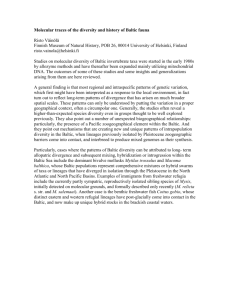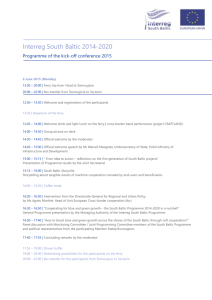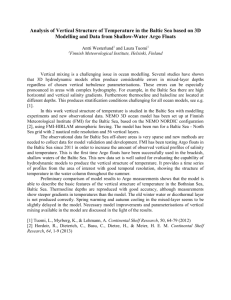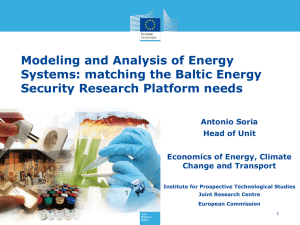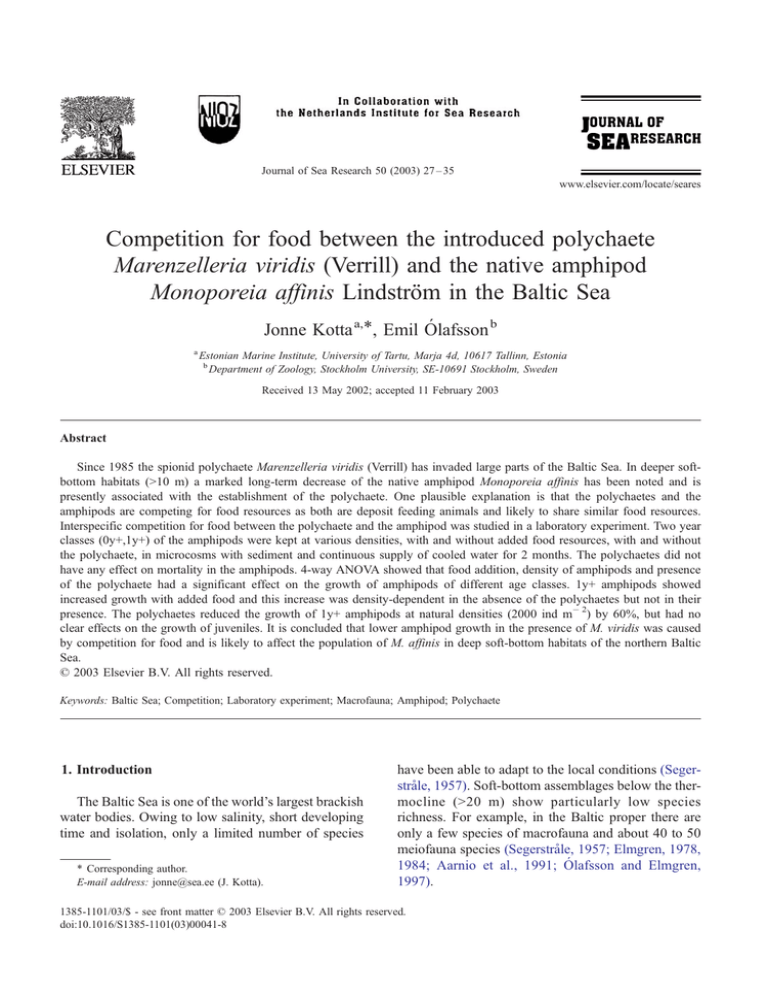
Journal of Sea Research 50 (2003) 27 – 35
www.elsevier.com/locate/seares
Competition for food between the introduced polychaete
Marenzelleria viridis (Verrill) and the native amphipod
Monoporeia affinis Lindström in the Baltic Sea
Jonne Kotta a,*, Emil Ólafsson b
a
Estonian Marine Institute, University of Tartu, Marja 4d, 10617 Tallinn, Estonia
b
Department of Zoology, Stockholm University, SE-10691 Stockholm, Sweden
Received 13 May 2002; accepted 11 February 2003
Abstract
Since 1985 the spionid polychaete Marenzelleria viridis (Verrill) has invaded large parts of the Baltic Sea. In deeper softbottom habitats (>10 m) a marked long-term decrease of the native amphipod Monoporeia affinis has been noted and is
presently associated with the establishment of the polychaete. One plausible explanation is that the polychaetes and the
amphipods are competing for food resources as both are deposit feeding animals and likely to share similar food resources.
Interspecific competition for food between the polychaete and the amphipod was studied in a laboratory experiment. Two year
classes (0y+,1y+) of the amphipods were kept at various densities, with and without added food resources, with and without
the polychaete, in microcosms with sediment and continuous supply of cooled water for 2 months. The polychaetes did not
have any effect on mortality in the amphipods. 4-way ANOVA showed that food addition, density of amphipods and presence
of the polychaete had a significant effect on the growth of amphipods of different age classes. 1y+ amphipods showed
increased growth with added food and this increase was density-dependent in the absence of the polychaetes but not in their
presence. The polychaetes reduced the growth of 1y+ amphipods at natural densities (2000 ind m 2) by 60%, but had no
clear effects on the growth of juveniles. It is concluded that lower amphipod growth in the presence of M. viridis was caused
by competition for food and is likely to affect the population of M. affinis in deep soft-bottom habitats of the northern Baltic
Sea.
D 2003 Elsevier B.V. All rights reserved.
Keywords: Baltic Sea; Competition; Laboratory experiment; Macrofauna; Amphipod; Polychaete
1. Introduction
The Baltic Sea is one of the world’s largest brackish
water bodies. Owing to low salinity, short developing
time and isolation, only a limited number of species
* Corresponding author.
E-mail address: jonne@sea.ee (J. Kotta).
have been able to adapt to the local conditions (Segerstråle, 1957). Soft-bottom assemblages below the thermocline (>20 m) show particularly low species
richness. For example, in the Baltic proper there are
only a few species of macrofauna and about 40 to 50
meiofauna species (Segerstråle, 1957; Elmgren, 1978,
1984; Aarnio et al., 1991; Ólafsson and Elmgren,
1997).
1385-1101/03/$ - see front matter D 2003 Elsevier B.V. All rights reserved.
doi:10.1016/S1385-1101(03)00041-8
28
J. Kotta, E. Ólafsson / Journal of Sea Research 50 (2003) 27–35
The amphipod Monoporeia affinis is found in soft
sediments below 10 m practically all over the Baltic
Sea. It shares its habitat with relatively few other macrofauna species and is ranked among the most abundant members in this biotope. During spring and
summer the densities of M. affinis are normally 1000
to 2000 adults m 2 in the northern Baltic proper
(Cederwall, 1977; Laine et al., 1997). In March – April,
when juveniles (0y+) are released from the marsupium, the natural abundance may exceed 15 000 ind
m 2 (Järvekülg, 1973; Sarvala and Uitto, 1991). The
amphipods may affect the structure of benthic assemblages through high consumption of sedimented phytoplankton (e.g. Lehtonen and Andersin, 1998) and
bioturbation (e.g. Ólafsson and Elmgren, 1991). They
are important in the Baltic Sea food web, being
efficient consumers of settling spring bloom phytodetritus (Lopez and Elmgren, 1989; Van de Bund et al.,
2001) and being preyed upon by a number of dermersal fish and benthic invertebrate species (e.g. Segerstråle, 1937; Leonardsson, 1991; Hill and Elmgren,
1992; Arrhenius and Hansson, 1993; Hüssy et al.,
1997).
It is likely that intraspecific competition occurs in
M. affinis populations in the Baltic Sea. Juveniles and
adults share the same food resources and the same
habitat. Fluctuations in the numbers of M. affinis
correlate with primary production values (Elmgren,
1978; Uitto and Sarvala, 1990; Sarvala and Uitto,
1991) and the growth of amphipods seems to be
density-dependent (Sarvala, 1986; Leonardsson,
1994). In addition to these observations, there is
experimental evidence that there is competition for
food within and between year classes of M. affinis
(Hill, 1992; Elmgren et al., 2001; Wenngren and
Ólafsson, 2002).
Biological invasions are known to cause large-scale
ecological changes and economic damage world wide.
The examples of invasions in the 1980s and 1990s have
shown that successful exotics may render previously
stable systems unbalanced and unpredictable (Leppäkoski, 1991; Carlton and Geller, 1993; Mills et al.,
1993; Carlton, 1996; Ruiz et al., 1999) and may
severely affect biological diversity in the area (Baker
and Stebbins, 1965; Gollasch and Leppäkoski, 1999;
Gollasch et al., 1999; Levine and D’Antonio, 1999). A
number of benthic animals presently living in the Baltic
have only recently invaded the area, some only in the
last decades or years (Gruszka, 1999; Olenin and
Leppäkoski, 1999).
Since 1985 the North-American detritus feeding
polychaete Marenzelleria viridis (Verrill) has invaded
large parts of the Baltic Sea (e.g. Essink and Kleef,
1993; Stigzelius et al., 1997; Olenin and Leppäkoski,
1999; Kotta and Orav, 2001). The appearance of
Marenzelleria in the North Sea and the Baltic Sea is
considered to represent independent introductions
(Essink, 1999). The Baltic M. cf. viridis is distinguished from the North Sea populations of M. cf. wireni
on the basis of morphological, reproductional and
genetical differences (Bastrop et al., 1997; Bick and
Zettler, 1997; Bochert, 1997).
In several shallow soft-bottom biotopes in the
Baltic, M. viridis has become a dominant macrofauna
species at densities up to 270 000 ind m 2. In general,
the density of the polychaete decreases with increasing
latitude (Zettler et al., 1995; Zettler, 1997). In the soft
sediments below 10 m, however, the polychaetes are
encountered in low but stable numbers, i.e. < 200 ind
m 2 (Kube et al., 1996; Stigzelius et al., 1997;
Ojaveer et al., 1999; Kotta, 2000), but may reach
2000 ind m 2 in areas of organic enrichment (Cederwall et al., 1999).
There exists circumstantial evidence that after the
invasion of M. viridis the densities of the shallowwater amphipod Corophium volutator (Pallas) (Atkins
et al., 1987; Zettler, 1996), the polychaete Nereis
diversicolor (O. F. Müller) (Atkins et al., 1987; Essink
and Kleef, 1993) and the deep-water amphipod M.
affinis have dropped considerably (Cederwall et al.,
1999). In an in situ experimental study, Kotta et al.
(2001) demonstrated higher mortality of N. diversicolor in the presence of M. viridis than in its absence.
One plausible explanation is that the polychaetes and
the native fauna are competing for food resources as
both species are deposit feeding animals and therefore
may share the same food resources. On the other hand,
the decline of native fauna (M. affinis) in the Gulf of
Finland has not been fully synchronised with the
introduction of M. viridis (Kangas et al., 2001; A.
Laine, pers. comm., 2002).
In this paper we investigate whether the introduced
polychaete M. viridis has negative effects on growth
and mortality of the native amphipod M. affinis. If
food competition occurs we expect to observe reduced
growth of the amphipods in the presence of the
J. Kotta, E. Ólafsson / Journal of Sea Research 50 (2003) 27–35
polychaetes at elevated food level, whereas we would
attribute negative effects in the presence of the polychaetes at severely limited food resources to other
interference mechanisms (e.g. direct damage or predation). We were interested in testing the effect of the
polychatetes on the amphipods at conditions similar to
the deeper parts of the northern Baltic Sea. Therefore
our experiment included one food level equivalent to
spring bloom (and a no-food control), the field densities of amphipods (three levels for both juveniles
and adults) and polychaetes (one level and a zero
control).
2. Material and methods
The experiment was carried out at the Askö laboratory in the north-western Baltic Sea proper (58j49VN,
17j34VE). Altogether 120 microcosms were used to
permit 24 treatments replicated 5 times. Two year
classes (0y+, 1y+) of M. affinis were kept at average,
high and very high densities and M. viridis was added at
zero and high densities typical of deep soft bottoms of
the northern Baltic Sea. The microcosms were seeded
with a mixture of algae (see below) or left without food
(Table 1).
Sediment and M. affinis used in the experiment
were sampled at a 28-m-deep muddy station in the
vicinity of the laboratory. Prior to the onset of the
spring bloom (10 March 1999), sediment samples
were taken with a van Veen grab. The sediment
(muddy silt) was sieved through a 300 Am mesh to
homogenise it and to remove all macrofauna. It was
stored aerated at 7 jC in the dark (to keep photosynthetic processes at minimum). M. affinis were collected
with a benthic sledge (Blomqvist and Lundgren, 1996)
4 days before the start of the experiment. The sediment
was immediately sieved through 1 and 0.5 mm sieves
and 1-y-old (1y+) and juveniles of M. affinis (0y+)
were picked up in batches of 10 with a small piece of
nylon net.
In 1999 M. viridis was found in very few localities
in the Askö area and the densities were too low to
satisfy the purpose of our experiment. Therefore, M.
viridis were collected from the Greifswalder Bodden,
southern Baltic Sea (54j09V N, 13j38VE) where the
worms occurred at high densities. The specimens of
M. viridis in Greifswalder Bodden and Askö areas are
29
Table 1
Experimental setup of investigating the effect of Marenzelleria
viridis on 0y+ (juv) and 1y+ (ad) Monoporeia affinis at different
population densities (ind per microcosm) and food regimes
Treatment
1
2
3
4
5
6
7
8
9
10
11
12
13
14
15
16
17
18
19
20
21
22
23
24
M. affinis
M. viridis
Density
Age
Density
20
20
20
20
40
40
40
40
80
80
80
80
20
20
20
20
40
40
40
40
80
80
80
80
ad
ad
juv
juv
ad
ad
juv
juv
ad
ad
juv
juv
ad
ad
juv
juv
ad
ad
juv
juv
ad
ad
juv
juv
2
2
2
2
2
2
2
2
2
2
2
2
0
0
0
0
0
0
0
0
0
0
0
0
Food added
yes
no
yes
no
yes
no
yes
no
yes
no
yes
no
yes
no
yes
no
yes
no
yes
no
yes
no
yes
no
In order to obtain the densities per m2 the values should be
multiplied by 100. Five replicates were analysed for each treatment.
considered to belong to the same population, originating from the same introduction event (Essink,
1999). The polychaetes were sampled from a siltysand bottom at 2 m depth on 16 April and held
aerated with sediment at 7 jC (both during transportation and storing at the Askö laboratory). The
salinity in Greifswalder Bodden and Askö area was
similar (f 6 PSU).
Prior to the start of the experiment, the sediment
was thoroughly mixed to ensure homogeneity. Cylindrical plastic jars (100 cm2) were filled with a 6 cm
layer of sediment and a 6 cm layer of water (Fig. 1)
and allowed to settle for 24 h. Then polychaetes
(mean length 62 F S.E. 2 mm) were randomly chosen
and added to the microcosms at densities (200 m 2)
that correspond to the high field abundances as found
in the deeper parts (>10 m) of the northern Baltic
Sea. This was done to increase the chances of
detecting any possible negative effects at field levels.
30
J. Kotta, E. Ólafsson / Journal of Sea Research 50 (2003) 27–35
Fig. 1. Experimental setup of microcosms. (A) 20 Am mesh, (B) 200
Am mesh. Arrows show the direction of water flow.
One day later (30 April) M. affinis were added to the
microcosms (juveniles: mean length 1.71 F 0.02,
mean dry weight (60 jC, 48 h) 61 F 10 Ag, adults:
mean length 6.38 mm, mean dry weight 975 F 40
Ag). The microcosms were supplied with cooled
filtered (20 Am) seawater from 16 m depth (temperature 6.6 jC, salinity 6.0 PSU) at an average flow
rate of around 25 cm3 min 1. The experiment was
carried out in the dark.
The animals were fed with diatoms over three
weeks to imitate field conditions as far as possible.
A mixture of Skeletonema costatum (Greville) Cleve
(60%), Nitzschia closterium (Ehrenberg) W. Smith
(30%) and other algae (10%) was used. The algae
were cultured at 15 jC in artificial seawater (Kester et
al., 1967) at a salinity of 15 PSU with added nutrients,
trace metals and vitamins (Guillard, 1975). Prior to
food addition, the salinity of the culture was lowered to
6– 7 PSU by using filtered seawater. To facilitate algal
settlement, the water flow through the jars was stopped
for 5 h during the feeding procedure. The food was
given on average twice a week (1 g C m 2 per feeding).
A water sample for the culture was taken, filtered on
Whatman CF/F filter, and analysed for the carbon content. The feeding procedure was carried out until the
amount of food reached spring bloom sedimentation
values typical of the Askö area (5– 8 g C m 2) (Larsson
et al., 1986).
At the end of the experiment (64 days) animals
were sieved out of the sediment using a 300 Am net.
Living animals were counted and preserved in a 4%
formaldehyde solution of 6 PSU filtered seawater. The
lengths of all polychaetes and 20 randomly chosen
amphipods in each microcosm were measured by
camera lucida using a light microscope.
Because of the relatively high mortality rate of the
polychaetes (40%) at the end of the experiment, all
jars containing dead polychaetes were omitted from
statistical analyses. Some treatments had less mortality, but to keep the design balanced (Underwood,
1997) two replicate jars of each treatment without
polychaetes were omitted randomly resulting in 3
replicate jars of each treatment. Analyses of variance
(ANOVA) were performed to separate the effects of
density and food addition on amphipod growth, with
and without the polychaete. The power of the tests
was assessed by calculating A2 and extrapolated
from operating characteristic curves for fixed effects
in the ANOVA using the procedure in Montgomery
(1991). Length and weight data of M. affinis were
log (x) transformed while mortalities (proportions)
were arcsine transformed. Bartlett’s test was carried
out prior to the analyses and the results confirmed
the assumption of homoscedasticity (Sokal and
Rohlf, 1981).
3. Results
3.1. Growth in length
Food, density of amphipods and the presence of the
polychaetes had a significant effect on the growth of
amphipods. There was also a significant difference in
growth between juveniles and adults (4-way ANOVA,
Food: p < 0.001, Age: p < 0.001, Density: p < 0.05,
Marenzelleria: p < 0.05, Age Food: p < 0.001, Fig.
2, Table 2). Growth was significantly higher in microcosms where food was added except for the treatments
with 20 1-y-old (1y+) amphipods and M. viridis. No
significant differences were observed in juvenile (0y+)
growth at different amphipod densities and between the
treatments where M. viridis was present or absent. The
1y+ growth was density-dependent in the absence of
the polychaetes and not so in the presence of the
polychaetes, though this was significant only at
J. Kotta, E. Ólafsson / Journal of Sea Research 50 (2003) 27–35
31
Fig. 2. Mean growth in length ( F SE) of Monoporeia affinis in relation to food availability, amphipod density and presence of Marenzelleria
viridis.
p = 0.056 in a three way analysis of the variance (Table
2). At low densities (20 ind per microcosm) and with
food addition, the 1y+ amphipods grew faster in the
absence of the polychaetes than in their presence. The
polychaetes did not grow significantly during the
course of experiment (ANOVA, p>0.05).
Table 2
Summary of the ANOVA analyses on the growth (length) of the
amphipods
3.2. Growth in weight
Degrees of freedom
Factor
Effect
Error
4-way ANOVA: Both age classes
1
1
50
2
2
50
3
1
50
4
1
50
34
1
50
F
p-level
4.8
3.4
3806
93
45
0.033
0.040
0.000
0.000
0.000
3-way ANOVA: Adults
1
1
2
2
3
1
25
25
25
4.0
1.3
8.1
0.056
0.297
0.008
3-way ANOVA: Juveniles
1
1
2
2
3
1
25
25
25
1.9
3.8
90
0.185
0.036
0.000
Factors 1: Marenzelleria densities, 2: Monoporeia densities, 3:
Food, 4: Age class. Only significant interactions are shown.
The results of the growth in weight were similar to
growth in length. However, significant effects of Marenzelleria were not observed as p values for the 4 and 3
way ANOVA were 0.078 and 0.117, respectively.
3.3. Survival
The survival of amphipods was significantly affected by food addition and there was a difference between
year classes. The survival was not affected by amphipod density or the presence of the polychaetes (4-way
ANOVA, Food: p < 0.05, Age: p < 0.001, Density:
p>0.05, Marenzelleria: p>0.05, interaction terms not
significant). When food was available 84% of the 1y+
and 50% of the 0y+ amphipods survived the 64-d
experimental period. When no food was added the
survival of 1y+ and 0y+ amphipods was lower: 73%
and 35%, respectively.
32
J. Kotta, E. Ólafsson / Journal of Sea Research 50 (2003) 27–35
4. Discussion
The results of this experiment indicate that M.
viridis had a significant effect on the growth of 1y+
M. affinis when amphipod density was kept at an
average level (200 ind m 2) in the presence of an
optimal food level, i.e. equivalent to typical carbon
values for the spring bloom sedimentation in the Askö
area. When amphipod densities were higher M. viridis
had no effect on M. affinis. At higher amphipod
densities the food levels were probably always highly
suboptimal regardless of the presence of the polychaetes. Hence, the chances of detecting the interspecific food competition between the test animals were
reduced. However, when food was given, M. viridis
had no effect on 0y+ M. affinis regardless of amphipod density. Slightly reduced amphipod growth in the
presence of the polychaetes (though statistically nonsignificant) suggests food excess in these treatments
during the whole experiment. While we found a
statistically significant difference in growth in length
of the amphipods in treatments with and without the
worms in the 4-way ANOVA, this was not so clear in
the 3-way ANOVAs where the p-value was slightly
above the critical value of 0.05 for adults and well
above this value for the juveniles, viz. 0.185 (Table 2).
Adults and juveniles showed ca 60 and 13% more
increase in length, respectively, in the treatments with
food and at low amphipod density in the absence of
the worms than in their presence. Together with the
results from the 3-way ANOVA, which is obviously
less powerful to detect difference compared to the 4way ANOVA (see Underwood, 1997), this indicates
that the worms mainly affected the growth of adults.
The increase in the p-value from 0.033 to 0.078 when
weight is analysed instead of length is likely to be
caused by less homogenous values because weighings
were based on only one measurement while the length
was based on mean values of 20 individuals for each
replicate. It is likely that the presence of M. viridis
decreases the chances of individual adult amphipods
to make use of the available food resource. Although
our experiment did not demonstrate a direct effect of
M. viridis on the mortality of M. affinis, the polychaete may still indirectly, through the reduction of
growth, influence the population dynamics of amphipods. The reduction in the growth of amphipods
seems to prolong its generation time (Leonardsson
et al., 1988) and reduce its fecundity (Cederwall,
1977). Hence, the competitive interaction between
M. viridis and M. affinis is expected to change the
duration of the amphipod’s life cycle. Besides, higher
macrozoobenthos densities may induce higher swimming activity of M. affinis (cf. Lindström and Fortelius, 1990). Consequently, amphipods are longer
exposed to possible predation and, hence, population
size is likely to diminish.
The intraspecific competition for food between the
amphipods was important in the treatments without
M. viridis. The addition of food increased the growth
rates and decreased the mortalities of amphipods. At
higher densities the effect was less pronounced. Like
Wenngren and Ólafsson (2002) we found in some jars,
however, increased juvenile mortalities associated
with the food addition. Because M. affinis is known
to be sensitive to low oxygen concentrations (Johansson, 1997), this pattern was probably related to the
temporal hypoxia following the decomposition of
surplus organic matter. The rates of amphipod growth
and mortality estimated in this study are in accordance
with the values reported in Wenngren and Ólafsson
(2002). The intraspecific competition for food has
previously been documented within and between
different year classes of M. affinis (Hill, 1992; Elmgren et al., 2001; Wenngren and Ólafsson, 2002) and
was considered to be the main mechanism regulating
the population size in the field (Sarvala, 1986; Leonardsson, 1994).
During this study we did not observe a significant
growth of M. viridis. Low and insignificant growth
rates may have been due to the fact that we used adult
polychaetes and their initial length showed relatively
high variability.
The high mortality of the polychaetes in the experimental jars (40%) is a cause of concern. We omitted
practically all jars where mortality occurred, resulting
in a considerable reduction in total degrees of freedom in the 4-way ANOVA. This had little effect on
the power of detecting a difference of 20% in length
of 1y+ at alpha levels of 0.05, which remained high.
One could argue that the remaining worms were in
bad condition and therefore not capable of exerting
negative effects on the amphipods. This was found
unlikely for two reasons. Firstly, monitoring of the
jars indicated that the sediment surface in jars without
polychaete mortality showed signs of bioturbation,
J. Kotta, E. Ólafsson / Journal of Sea Research 50 (2003) 27–35
with distinct faecal casts on the surface sediment.
This was not observed in those jars where the two
specimens of M. viridis had died. Secondly, at the
end of the experiment surviving polychaetes showed
high vitality, with fast movements and escape behaviour. Further, the state of those individuals that had
died indicated that this must have happened early in
the experiment as their tissue was largely decomposed.
Another limitation of our experiment was the
thickness of the sediment in the microcosms. Since
M. viridis is a deep-burrowing polychaete (Hines and
Comtois, 1985), too thin sediment layers may increase the probability of encounters and interactions
between the test animals. However, in the deep softbottom habitats of the northern Baltic Sea it is likely
that, owing to reduced oxygen concentrations (e.g.
Kube and Powilleit, 1997) and increasing clay content, M. viridis does not penetrate very deep into the
sediment.
Competitive interactions for food between M. viridis and M. affinis may be more intense in eutrophicated and/or shallower areas where the density of the
polychaete often reaches over 3000 ind m 2 during
the later successional stages (Zettler, 1997). In the
Dollard (The Netherlands), however, Essink et al.
(1998) and Essink (1999) found considerable increase
in macrozoobenthic biomass after the introduction of
M. cf. wireni. They suggest that the polychaete was
filling an unused space, therefore not affecting the
resident fauna in other niches. Ever since the invasion
of M. cf. viridis in the Gulf of Riga (NE Baltic Sea),
the abundance of M. affinis has decreased notably in
the deeper areas but increased in the shallower areas
(Cederwall et al., 1999). They conclude that the
collapse of M. affinis in deeper sites of the Gulf of
Riga was primarily related to oxygen deficiency. The
densities of M. viridis were estimated at less than 500
ind m 2 and the polychaetes were not considered to
affect the native fauna. However, in recent years with
good oxygen regime and increasing densities of M.
viridis, no recovery of M. affinis has been observed in
the Gulf (Database of the Estonian Coastal Monitoring). This suggests stronger competitive interactions
between the species in the deeper areas while other
factors (e.g. unlimited food sources, interactions with
other species) may release amphipods from such
competition in the shallow water (Kotta et al., 2001).
33
To conclude, our experiment suggests that M.
viridis is able to reduce the growth of M. affinis in
the deep soft-bottom habitats in the northern Baltic
Sea. This negative effect may be attributed to food
competition rather than to other mechanisms of interference competition.
Acknowledgements
We thank the staff at the Askö Laboratory for their
assistance and its director Björn Ganning for making
facilities available. We thank Johan Wenngren for
help in setting up the experiment and Günther
Burkhardt for assistance with the collection of
Marenzelleria. Erik Bonsdorff commented on an
earlier draft of the manuscript. Karel Essink, Ari
Laine and another anonymous referee improved the
manuscript significantly. This research was supported
by the grants of the Swedish Institute, Stockholm
Marine Research Centre, the Estonian Governmental
Programme no 0182578s03, the Estonian Science
Foundation grant no 5103 and EU-Charm-project.
References
Aarnio, K., Sandberg, E., Bonsdorff, E., 1991. Benthic predation on
shallow-water macro- and meiofauna in the Baltic Sea: an experimental comparison between Potamoschistus minutus (Pisces) and Saduria entomon (Crustacea). Ann. Zool. Fenn. 28,
41 – 48.
Arrhenius, F., Hansson, S., 1993. Food-consumption of larval,
young and adult herring and sprat in the Baltic Sea. Mar. Ecol.
Prog. Ser. 96, 125 – 137.
Atkins, S.M., Jones, A.M., Garwood, P.R., 1987. The ecology and
reproductive cycle of a population of Marenzelleria viridis (Annelida: Polychaeta: Spionidae) in the Tay Estuary. Proc. R. Soc.
Edinburgh 92B, 311 – 322.
Baker, H., Stebbins, G., 1965. The Genetics of Colonizing Species.
Academic Press, New York.
Bastrop, R., Röhner, M., Sturmbauer, C., Jürss, K., 1997. Where
did Marenzelleria spp. (Polychaeta: Spionidae) in Europe come
from? Aquat. Ecol. 31, 119 – 136.
Bick, A., Zettler, M.L., 1997. On the identity and distribution of
two species of Marenzelleria (Polychaeta: Spionidae) in Europe
and North America. Aquat. Ecol. 31, 119 – 136.
Blomqvist, S., Lundgren, L., 1996. A benthic sled for sampling soft
bottoms. Helgoländer Meeresunters. 50, 453 – 456.
Bochert, R., 1997. Marenzelleria viridis (Polychaeta: Spionidae): a
review of its reproduction. Aquat. Ecol. 31, 163 – 175.
Carlton, J.T., 1996. Pattern, process, and prediction in marine invasion ecology. Biol. Conserv. 78, 97 – 106.
34
J. Kotta, E. Ólafsson / Journal of Sea Research 50 (2003) 27–35
Carlton, J.T., Geller, J.B., 1993. Ecological roulette: the global
transport of nonindigeneous marine organisms. Science 261,
78 – 82.
Cederwall, H., 1977. Annual macrofauna production of a soft bottom in the northern Baltic Proper. In: Keegan, B.F., Ceidigh,
P.O., Boaden, P.J.S. (Eds.), Biology of Benthic Organisms.
Proc. 11th Europ. Mar. Biol. Symp. Pergamon Press, Oxford,
pp. 155 – 164.
Cederwall, H., Jermakovs, V., Lagzdins, G., 1999. Long-term
changes in the soft-bottom macrofauna of the Gulf of Riga.
ICES J. Mar. Sci. 56, 41 – 48 (Suppl.).
Elmgren, R., 1978. Structure and dynamics of Baltic benthos communities, with particular reference to the relationship between
macro- and meiofauna. Kiel. Meeresforsch. 4, 1 – 22.
Elmgren, R., 1984. Trophic dynamics in the enclosed, brackish Baltic Sea. Rapp. P.-v. Réun. Cons. Int. Explor. Mer 183, 152 – 169.
Elmgren, R., Ejdung, G., Ankar, S., 2001. Intraspecific food competition in the deposit-feeding benthic amphipod Monoporeia
affinis - a laboratory study. Mar. Ecol. Prog. Ser. 210, 185 – 193.
Essink, K., 1999. Dispersal and development of Marenzelleria spp.
(Polychaeta, Spionidae) populations in the NW Europe and The
Netherlands. Helgoländer Meeresunters. 52, 367 – 372.
Essink, K., Kleef, H.L., 1993. Distribution and life cycle of the
north American spionid polychaete Marenzelleria viridis (Verrill, 1873) in the Ems estuary. Neth. J. Aq. Ecol. 27, 237 – 246.
Essink, K., Eppinga, J., Dekker, R., 1998. Long-term changes
(1977 – 1994) in intertidal macrozoobenthos of the Dollard
(Ems Estuary) and effects of introduction of the North American
spionid polychaete Marenzelleria cf. wireni. Senckenb. Marit.
28, 211 – 225.
Gollasch, S., Leppäkoski, E. (Eds.), 1999. Initial Risk Assessment
of Alien Species in Nordic Coastal Waters. Nordic Council of
Ministers, Copenhagen.
Gollasch, S., Minchin, D., Rosenthal, H., Voigt, M. (Eds.), 1999.
Exotics Across the Ocean - Case Histories on Introduced Species. Dep. Fish. Biol., Inst. Mar. Sci., Univ., Kiel, Germany.
Gruszka, P., 1999. The River Odra estuary as a gateway for alien
species immigration to the Baltic Sea basin. Acta Hydrochim.
Hydrobiol. 27, 374 – 382.
Guillard, R.L., 1975. Culture of phytoplankton for feeding marine invertebrates. In: Smith, W.L., Chanley, M.H. (Eds.),
Culture of Marine Invertebrate Animals. Plenum Press, New
York, pp. 29 – 60.
Hill, C., 1992. Interactions between year classes in the benthic
amphipod Monoporeia affinis: effects on juvenile survival and
growth. Oecologia 91, 157 – 162.
Hill, C., Elmgren, R., 1992. Predation by the isopod Saduria entomon on the amphipods Monoporeia affinis and Pontoporeia
femorata: experiments on prey vulnerability. Oecologia 91,
153 – 156.
Hines, A.H., Comtois, K.L., 1985. Vertical distribution of estuarine
infauna in sediment of a subestuary of central Chesapeake Bay.
Estuaries 8, 296 – 304.
Hüssy, K., St. John, M.A., Böttcher, U., 1997. Food resource utilization by juvenile Baltic cod Gadus morhua: a mechanism
potentially influencing recruitment success at the demersal juvenile stage? Mar. Ecol. Prog. Ser. 155, 199 – 208.
Johansson, B., 1997. Tolerance of the deposit-feeding Baltic amphipods Monoporeia affinis and Pontoporeia femorata to oxygen deficiency. Mar. Ecol. Prog. Ser. 151, 135 – 141.
Järvekülg, A., 1973. Distribution and ecology of local populations
of benthic glacial relicts. Oikos Suppl. 15, 91 – 97.
Kangas, P., Byholm, L., Stigzelius, J., 2001. Changes in zoobenthos
communities. In: Kauppila, P., Bäck, S. (Eds.), The State of
Finnish Coastal Waters in the 1990s. The Finnish Environment,
vol. 472, pp. 79 – 88.
Kester, D.R., Duedall, I.W., Connors, D.N., Pykovocz, R.M.,
1967. Preparation of artificial seawater. Limnol. Oceanogr.
12, 176 – 179.
Kotta, J., 2000. Impact of eutrophication and biological invasions
on the structure and functions of benthic macrofauna. Dissertationes Biologicae Universitatis Tartuensis, vol. 63. Tartu University Press, Tartu.
Kotta, J., Orav, H., 2001. Factors affecting the distribution, abundance and biomass of invertebrate fauna in the Väinameri
(north-eastern Baltic Sea). Ann. Zool. Fenn. 38, 163 – 171.
Kotta, J., Orav, H., Sandberg-Kilpi, E., 2001. Ecological consequence of the introduction of the polychaete Marenzelleria cf
viridis into a shallow-water biotope of the northern Baltic Sea.
J. Sea Res. 46, 273 – 280.
Kube, J., Powilleit, M., 1997. Factors controlling the distribution of
Marenzelleria cf. viridis, Pygospio elegans and Streblospio
shrubsoli (Polychaeta: Spionidae) in the southern Baltic Sea,
with special attention for the response to an event of hypoxia.
Aquat. Ecol. 31, 187 – 198.
Kube, J., Zettler, M.L., Gosselck, F., Ossig, S., Powilleit, M., 1996.
Distribution of Marenzelleria viridis (Polychaeta: Spionidae) in
the southwestern Baltic Sea in 1993/94 - ten years after introduction. Sarsia 81, 131 – 142.
Laine, A.O., Sandler, H., Andersin, A.-B., Stigzelius, J., 1997.
Long-term changes of macrozoobenthos in the Eastern Gotland
Basin and the Gulf of Finland (Baltic Sea) in relation to the
hydrographical regime. J. Sea Res. 38, 135 – 159.
Larsson, U., Hobro, R., Wulff, F., 1986. Dynamics of phytoplankton spring bloom in a coastal area of the northern Baltic proper.
Contrib. Askö Lab. Univ. Stockholm 30, 1 – 32.
Lehtonen, K., Andersin, A.-B., 1998. Population dynamics, response to sedimentation and role in benthic metabolism of the
amphipod Monoporeia affinis in an open-sea area of the northern Baltic Sea. Mar. Ecol. Prog. Ser. 168, 71 – 85.
Leonardsson, K., 1991. Effects of cannibalism and alternative prey
on population dynamics of Saduria entomon (Isopoda). Ecology
72, 1273 – 1285.
Leonardsson, K., 1994. Multiple density dependence in two subpopulations of the amphipod Monoporeia affinis: a potential for
alternative prey. Oecologia 97, 26 – 34.
Leonardsson, K., Sörlin, T., Samberg, H., 1988. Does Pontoporeia
affinis (Amphipoda) optimize age at reproduction in the Gulf of
Bothnia? Oikos 52, 328 – 336.
Leppäkoski, E., 1991. Introduced species - resource or threat in
brackish water seas? Examples from the Baltic and the Black
Sea. Mar. Pollut. Bull. 23, 219 – 223.
Levine, J.M., D’Antonio, C.M., 1999. Elton revisited: a review of
evidence linking diversity and invasibility. Oikos 87, 15 – 26.
J. Kotta, E. Ólafsson / Journal of Sea Research 50 (2003) 27–35
Lindström, M., Fortelius, W., 1990. Some factors affecting the
horizontal migration of Pontoporeia affinis (Crustacea, Amphipoda) in laboratory conditions. Ann. Zool. Fenn. 27, 309 – 312.
Lopez, G., Elmgren, R., 1989. Feeding depths and organic absorption for the deposit-feeding amphipods Pontoporeia affinis and
P. femorata. Limnol. Oceanogr. 34, 982 – 991.
Mills, E.L., Leach, J.H., Carlton, J.T., Secor, C.L., 1993. Exotic
species in the Great Lakes: a history of biotic crises and anthropogenic introductions. J. Great Lakes Res. 19, 1 – 54.
Montgomery, D.C., 1991. Design and Analysis of Experiments, 3rd
ed. Wiley, New York.
Ojaveer, H., Lankov, A., Eero, M., Kotta, J., Kotta, I., Lumberg, A.,
1999. Changes in the ecosystem of the Gulf of Riga from the
1970s to the 1990s. ICES J. Mar. Sci. Suppl. 56, 33 – 40.
Ólafsson, E., Elmgren, R., 1991. Effects of biological disturbance
by benthic amphipods Monoporeia affinis on meiobenthic community structure: a laboratory approach. Mar. Ecol. Prog. Ser.
74, 99 – 107.
Ólafsson, E., Elmgren, R., 1997. Seasonal dynamics of sublittoral
meiobenthos in relation to phytoplankton sedimentation in the
Baltic Sea. Estuar. Coast. Shelf Sci. 45, 149 – 164.
Olenin, S., Leppäkoski, E., 1999. Non-native animals in the Baltic
Sea: alteration of benthic habitats in coastal inlets and lagoons.
Hydrobiologia 393, 233 – 243.
Ruiz, G.M., Fofonoff, P., Hines, A.H., 1999. Non-indigeneous
species as stressors in estuarine and marine communities: assessing invasion impacts and interactions. Limnol. Oceanogr.
44, 950 – 972.
Sarvala, J., 1986. Interannual variation of growth and recruitment in
Pontoporeia affinis (Lindström) (Crustacea: Amphipoda) in relation to abundance fluctuations. J. Exp. Mar. Biol. Ecol. 101,
41 – 59.
Sarvala, J., Uitto, A., 1991. Production of benthic amphipods Pontoporeia affinis and P. femorata in a Baltic archipelago. Ophelia
34, 71 – 90.
Segerstråle, S., 1937. Studien über die Bodentierwelt in südfinnlän-
35
dischen Küstengewässern, V: Das reife Pontoporeia affinis-Männchen (‘‘P. weltneri’’) als Saisonnahrung für der Stint (Osmerus
eperlanus L.). Commentat. Biol. Soc. Sci. Fenn. 7, 1 – 17.
Segerstråle, S., 1957. Baltic Sea. Mem. Geol. Soc. Am. 67,
757 – 800.
Sokal, R.R., Rohlf, F.J., 1981. Biometry. W.H. Freeman & Company, San Francisco.
Stigzelius, J., Laine, A., Rissanen, J., Andersin, A.-B., Ilus, E.,
1997. The introduction of Marenzelleria viridis (Polycheata,
Spionidae) into the Gulf of Finland and the Gulf of Bothnia
(northern Baltic Sea). Ann. Zool. Fenn. 34, 205 – 212.
Uitto, A., Sarvala, J., 1990. Perspectives on the ecological factors
regulating Pontoporeia populations in the northern Baltic Sea.
Ann. Zool. Fenn. 27, 297 – 301.
Underwood, A.J., 1997. Experiments in Ecology: Their Logical
Design and Interpretation Using Analysis of Variance. Cambridge University Press, Cambridge.
Van de Bund, W.J., Ólafsson, E., Modig, H., Elmgren, R., 2001.
Effects of the coexisting amphipods Monoporeia affinis and
Pontoporeia femorata on the fate of a simulated spring diaton
bloom. Mar. Ecol. Prog. Ser. 212, 107 – 115.
Wenngren, J., Ólafsson, E., 2002. Intraspecific competition for food
within and between year-classes in the deposit feeding amphipod Monoporeia affinis - the cause of population fluctuations?
Mar. Ecol. Prog. Ser. 240, 205 – 213.
Zettler, M.L., 1996. Successful establishment of the spionid polychaete, Marenzelleria viridis (Verrill, 1873), in the Darss-Zingst
estuary (southern Baltic) and its influence on the indigeneous
macrozoobenthos. Arch. Fish. Mar. Res. 43, 273 – 284.
Zettler, M.L., 1997. Bibliography on the genus Marenzelleria and
its geographical distribution, principal topics and nomenclature.
Aq. Ecol. 31, 233 – 258.
Zettler, M.L., Bick, A., Bochert, R., 1995. Distribution and population dynamics of Marenzelleria viridis (Polychaeta: Spionidae) in a coastal water of southern Baltic. Arch. Fish. Mar.
Res. 42, 209 – 224.

